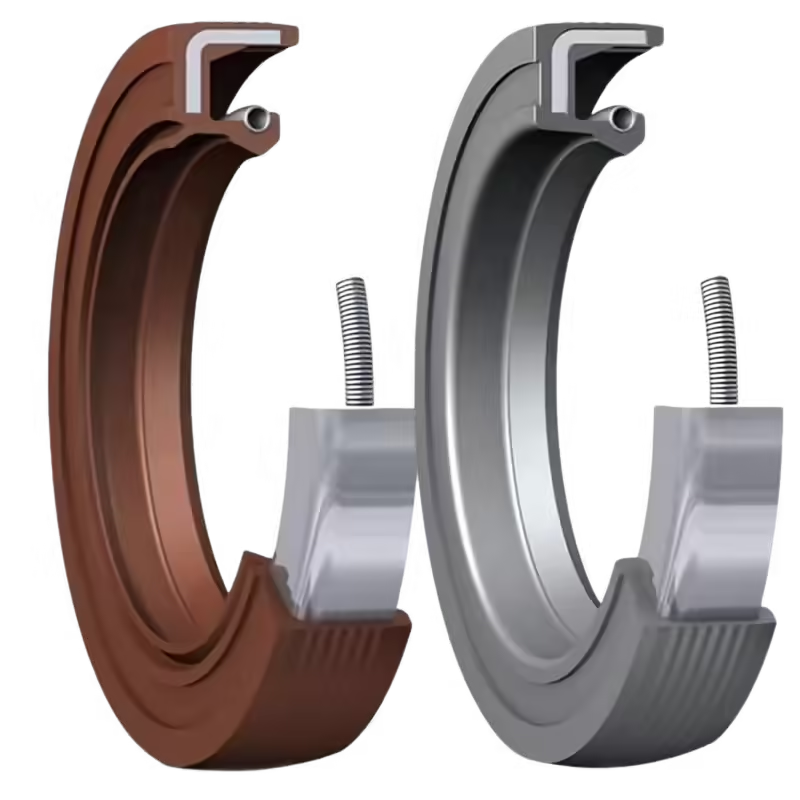Does Transmission Fluid, Hydraulic Fluid, or Engine Oil Damage Rubber Seals?
Introduction
Rubber seals play a crucial role in various automotive systems, including transmission, hydraulic, and engine systems. The quality and performance of these seals directly impact the overall efficiency and longevity of a vehicle. Common automotive fluids—transmission fluid, hydraulic fluid, and engine oil—serve essential functions such as lubrication, cooling, and power transmission. However, these fluids can also affect rubber seals and materials in different ways. This article explores how these fluids impact rubber seals, providing valuable insights for vehicle owners and maintenance professionals to better understand and maintain their vehicle’s sealing systems.
1. What is Transmission Fluid?
Definition and Function
Transmission fluid is a specialized lubricant used in automotive transmission systems, including both automatic and manual transmissions. Its primary functions include lubricating the internal gears and components, reducing friction and wear, facilitating power transmission, and aiding in cooling the transmission system.
Chemical Composition
Transmission fluid typically consists of a base oil and various additives. The base oil can be mineral-based, synthetic, or semi-synthetic, while additives may include antioxidants, anti-wear agents, corrosion inhibitors, and viscosity improvers. These components work together to provide excellent lubrication performance and stability under varying operating conditions.
Potential Impact on Rubber Seals
Prolonged exposure to transmission fluid can adversely affect rubber seals. Certain chemical components in transmission fluid, particularly additives, may cause rubber materials to swell, soften, crack, or even leak over time. This degradation compromises the functionality of the transmission system, leading to reduced performance and potential mechanical failures.
2. What is Hydraulic Fluid?
Definition and Role
Hydraulic fluid is the working medium in hydraulic systems, widely used in brake systems, steering systems, and lifting mechanisms. Its main role is to transmit hydraulic pressure, enabling the operation of various system functions through fluid power.
Types of Hydraulic Fluids
Hydraulic fluids can be categorized based on their base oil:
- Mineral Oil-Based: Commonly used due to their cost-effectiveness and satisfactory performance.
- Water-Based: Used in specific applications requiring lower environmental impact and different performance characteristics.
- Synthetic: Offer superior performance in extreme temperatures and enhanced chemical stability.
Chemical Interaction with Rubber
The interaction between hydraulic fluid and rubber seals largely depends on the type and chemical composition of the fluid. Mineral oil-based hydraulic fluids can cause rubber seals to swell, harden, or crack, thereby reducing their sealing effectiveness. Some synthetic hydraulic fluids are less aggressive but can still lead to seal degradation over extended periods of exposure.
3. What is Engine Oil?
Function and Composition
Engine oil is essential for lubricating, cleaning, and cooling the internal components of an engine, ensuring its smooth operation. Engine oil comprises a base oil and a variety of additives, including detergents, antioxidants, anti-wear agents, and viscosity modifiers, which enhance its performance and protective qualities.
Different Types of Engine Oil
Engine oils are categorized based on their synthesis:
- Conventional Mineral Oil: Derived from crude oil, suitable for standard engine requirements.
- Synthetic Oil: Engineered for superior high-temperature stability and low-temperature flow, offering enhanced protection.
- Semi-Synthetic Oil: A blend of conventional and synthetic oils, providing a balance between performance and cost.
Effect of Engine Oil on Rubber Seals
Engine oil, particularly synthetic varieties, can affect rubber seals by either softening or hardening the rubber, depending on the oil formulation and exposure duration. Prolonged contact with engine oil can lead to the aging, cracking, or leaking of rubber seals and gaskets, thereby compromising the engine’s sealing integrity and overall performance.
4. The Role of Rubber Seals in Automotive Systems
Function
Rubber seals in automotive systems serve to seal, prevent leaks, and protect internal components from contamination. They ensure the effective transmission of fluids within systems and block the ingress of external contaminants, maintaining the integrity and efficiency of the system.
Common Types
Common rubber seals include:
- O-Rings: Circular seals used to prevent fluid leakage between connected components.
- Gaskets: Flat seals used to fill the space between two or more mating surfaces.
- Lip Seals: Seals with a flexible lip that prevents fluid leakage while allowing movement of components.
Material Properties
Rubber seals are typically made from materials such as natural rubber, nitrile rubber, and fluorocarbon rubber. These materials are chosen for their flexibility, durability, and resistance to specific chemicals, enabling them to perform reliably under high pressure, high temperature, and various fluid environments.
5. How Transmission Fluid Affects Rubber Seals
Chemical Interactions
Transmission fluid contains additives that can chemically interact with rubber materials, leading to the breakdown of rubber properties over time. Continuous exposure can cause the rubber to swell, soften, and lose its elasticity, making it more susceptible to cracking and leakage.
Potential Damage
The degradation mechanisms include:
- Swelling: Increased volume of the rubber seal, leading to loss of dimensional stability.
- Softening: Reduced hardness and increased flexibility, compromising the seal’s ability to contain fluids.
- Cracking: Formation of fissures that allow fluid leakage.
- Leaking: Direct loss of fluid due to compromised seal integrity.
Symptoms of Damaged Seals
Common indicators of damaged rubber seals include:
- Fluid Leaks: Visible transmission fluid around seals.
- Slipping Gears: Reduced transmission performance due to inadequate lubrication.
- Poor Transmission Performance: Difficulty in gear shifting and reduced overall efficiency.
6. How Hydraulic Fluid Affects Rubber Seals
Chemical Reactions
Hydraulic fluids, especially those based on mineral oils, can adversely interact with rubber seals. These interactions can cause the seals to swell, harden, or crack, diminishing their sealing capabilities and leading to system inefficiencies.
Potential Issues
Long-term exposure to hydraulic fluid can result in:
- Swelling: Altered dimensions of the rubber seal.
- Hardening: Increased brittleness making the seal prone to cracking.
- Cracking: Formation of fissures compromising the seal.
- Reduced Sealing Performance: Ineffective containment of hydraulic fluids, leading to leaks and decreased system performance.
Common Problems
Degraded seals in hydraulic systems can lead to:
- Pressure Loss: Reduced hydraulic pressure affecting system functionality.
- Delayed Response: Slower system reactions due to compromised fluid flow.
- System Leaks: Fluid escaping from the system, potentially causing safety hazards.
Factors Influencing Damage
The extent of damage to rubber seals by hydraulic fluid depends on:
- Type of Hydraulic Fluid: Mineral-based fluids are more aggressive compared to synthetic alternatives.
- Exposure Time: Longer contact periods increase the likelihood of seal degradation.
- Temperature: Elevated temperatures can accelerate chemical reactions damaging the seals.
- Rubber Material Compatibility: Some rubber compounds are more resistant to specific fluids than others.
7. How Engine Oil Affects Rubber Seals
Impact on Seals
Engine oil primarily affects rubber seals located in valve covers, oil pans, and gaskets. These seals are in constant contact with engine oil, making them vulnerable to chemical interactions that can alter their properties.
Chemical Effects
Different types of engine oil interact differently with rubber seals:
- Synthetic Oils: Can soften rubber seals, reducing their firmness and effectiveness.
- Conventional Oils: May cause rubber to harden, leading to brittleness and cracking.
Long-Term Exposure
Prolonged exposure to engine oil can result in:
- Aging: Accelerated wear and tear of rubber seals.
- Cracking: Formation of fissures that allow oil leakage.
- Leakage: Loss of oil containment, leading to engine performance issues and potential damage.
8. Comparing the Effects of Transmission Fluid, Hydraulic Fluid, and Engine Oil on Rubber
Transmission Fluid vs. Hydraulic Fluid
Transmission fluid and hydraulic fluid have different chemical compositions, resulting in varied effects on rubber seals. Transmission fluid additives may cause rubber to soften and crack, while hydraulic fluids, particularly mineral-based ones, are more likely to cause swelling and hardening of seals.
Engine Oil vs. Hydraulic Fluid
Engine oil, especially synthetic types, tends to soften rubber seals, whereas hydraulic fluid can lead to hardening or cracking. Both fluids can degrade rubber seals over time, but the specific impact depends on the fluid’s formulation and the seal material’s compatibility.
Rubber Seal Materials and Fluid Compatibility
Selecting the appropriate rubber seal material based on fluid compatibility is essential. High-performance elastomers such as fluorocarbon rubber (Viton), nitrile rubber (Buna-N), and hydrogenated nitrile rubber (HNBR) offer better resistance to various automotive fluids, enhancing seal longevity and performance.
9. Preventing Damage to Rubber Seals
Routine Maintenance
Regularly checking fluid levels and quality helps prevent contamination and fluid degradation that can harm rubber seals. Routine inspections can identify early signs of seal wear and fluid issues, allowing for timely interventions.
Replacing Worn Fluids
Adhering to scheduled fluid replacement intervals for transmission fluid, hydraulic fluid, and engine oil minimizes the risk of using degraded or contaminated fluids that can corrode and wear out rubber seals.
Using Compatible Fluids
Ensuring the correct type of fluid is used for each system and that it is compatible with the rubber materials in the seals reduces the likelihood of chemical reactions that can damage seals.
Selecting the Right Rubber Seals
Choosing high-quality, durable rubber seals made from materials resistant to oil and chemical exposure, such as fluorocarbon rubber or nitrile rubber, enhances the seals’ ability to withstand fluid interactions and extend their service life.
10. Alternatives and Solutions for Long-Lasting Rubber Seals
Advanced Seal Materials
Utilizing high-performance elastomers like Viton, nitrile rubber, and fluorocarbon rubber can significantly improve seal resistance to automotive fluids. These materials offer superior oil resistance and chemical stability, making them ideal for challenging fluid environments.
Additives in Fluids
Incorporating specific additives into transmission fluid, hydraulic fluid, and engine oil can enhance the protection of rubber seals. These additives can form protective layers on seals, reducing direct contact with harmful chemicals and mitigating degradation.
Innovations in Seal Technology
Advancements in seal technology have led to the development of new materials and improved formulations that enhance the durability and reliability of rubber seals. Innovations such as multi-layer seals, reinforced elastomers, and improved curing processes contribute to longer-lasting seals in fluid-exposed environments.
Conclusion
Transmission fluid, hydraulic fluid, and engine oil are essential for the proper functioning of automotive systems, yet they can also pose risks to rubber seals. Understanding the interactions between these fluids and rubber materials is crucial for maintaining seal integrity and ensuring the longevity of vehicle systems. By selecting compatible seal materials, using appropriate fluids, and adhering to regular maintenance schedules, the damage to rubber seals can be minimized. Proactive maintenance and the use of high-quality materials are key strategies in preventing seal degradation and ensuring the reliable operation of automotive systems.
Contact Us
For more information, visit our website at drorubber.com.
- WhatsApp: +0086 15815831911
- WeChat: +0086 13784044874





